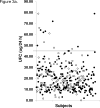Cortisol, obesity, and the metabolic syndrome: a cross-sectional study of obese subjects and review of the literature
- PMID: 23505190
- PMCID: PMC3602916
- DOI: 10.1002/oby.20083
Cortisol, obesity, and the metabolic syndrome: a cross-sectional study of obese subjects and review of the literature
Abstract
Objective: Circulating cortisol and psychosocial stress may contribute to the pathogenesis of obesity and metabolic syndrome (MS). To evaluate these relationships, a cross-sectional study of 369 overweight and obese subjects and 60 healthy volunteers was performed and reviewed the previous literature.
Design and methods: Overweight and obese subjects had at least two other features of Cushing's syndrome. They underwent measurements representing cortisol dynamics (24 h urine cortisol excretion (UFC), bedtime salivary cortisol, 1 mg dexamethasone suppression test) and metabolic parameters (BMI, blood pressure (BP); fasting serum triglycerides, HDL, insulin, and glucose). Subjects also completed the Perceived Stress Scale (PSS). UFC, salivary cortisol, and weight from 60 healthy volunteers were analyzed.
Results: No subject had Cushing's syndrome. UFC and dexamethasone responses were not associated with BMI or weight. However, salivary cortisol showed a trend to increase as BMI increased (P < 0.0001), and correlated with waist circumference (WC) in men (rs = 0.28, P = 0.02) and systolic BP in women (rs = 0.24, P = 0.0008). Post-dexamethasone cortisol levels were weak to moderately correlated with fasting insulin (rs = -0.31, P = 0.01) and HOMA-IR (rs = -0.31, P = 0.01) in men and systolic (rs = 0.18, P = 0.02) and diastolic BP (rs = 0.20, P = 0.009) in women. PSS results were higher in obese subjects than controls, but were not associated with cortisol or metabolic parameters. As expected, WC correlated with fasting insulin, HOMA-IR, and systolic BP (adjusted for BMI and gender; P < 0.01). Literature showed inconsistent relationships between cortisol and metabolic parameters.
Conclusion: Taken together, these data do not support a strong relationship between systemic cortisol or stress and obesity or MS.
Copyright © 2013 The Obesity Society.
Figures





References
-
- Flegal KM, Graubard BI, Williamson DF, Gail MH. Cause-specific excess deaths associated with underweight, overweight, and obesity. JAMA. 2007;298:2028–37. - PubMed
-
- Pivonello R, Faggiano A, Lombardi G, Colao A. The metabolic syndrome and cardiovascular risk in Cushing’s syndrome. Endocrinol Metab Clin North Am. 2005;34:327–39. viii. - PubMed
-
- Marin P, Darin N, Amemiya T, Andersson B, Jern S, Bjorntorp P. Cortisol secretion in relation to body fat distribution in obese premenopausal women. Metabolism. 1992;41:882–6. - PubMed
-
- Pasquali R, Anconetani B, Chattat R, et al. Hypothalamic-pituitary-adrenal axis activity and its relationship to the autonomic nervous system in women with visceral and subcutaneous obesity: effects of the corticotropin-releasing factor/arginine-vasopressin test and of stress. Metabolism. 1996;45:351–6. - PubMed
-
- Phillips DIW, Barker DJP, Fall CHD, et al. Elevated plasma cortisol concentrations: A link between low birth weight and the insulin resistance syndrome? J Clin Endocrinol Metab. 1998;83:757–60. - PubMed
Publication types
MeSH terms
Substances
Grants and funding
LinkOut - more resources
Full Text Sources
Other Literature Sources
Medical
Research Materials

